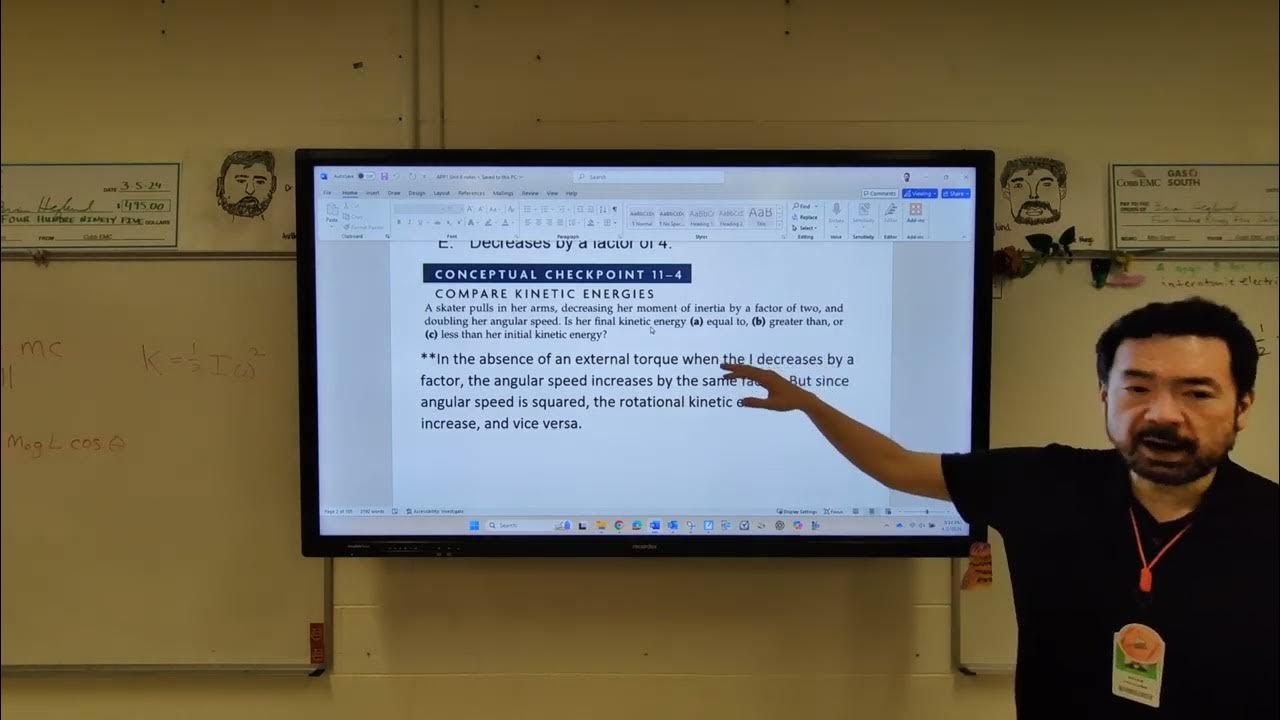Tensor Inersia
Summary
TLDRThe video script discusses the concept of rotational inertia and angular momentum, focusing on how rotational motion relates to linear velocity and mass distribution. It explains the mathematical formulas for angular velocity, tangential velocity, and the moment of inertia, incorporating the role of different mass elements in a rotating object. The script goes further to explore the behavior of angular momentum in objects with continuous mass distribution and its interaction with components of rotational velocity along different axes. Examples, including the calculation of moment of inertia for a cube, illustrate these principles.
Takeaways
- 😀 The concept of angular velocity (omega) is introduced as a key component in circular motion, determining the tangential velocity of rotating objects.
- 😀 Tangential velocity is defined as the velocity that is tangent to the circular path of a moving object, with its magnitude given by the product of angular velocity (omega) and the radius (r).
- 😀 Each element of a rotating object has its own tangential velocity, which depends on its distance from the center of rotation.
- 😀 The linear momentum of an element of mass is given by the product of its mass (dm) and velocity (v), with the momentum vector perpendicular to both the position and velocity vectors.
- 😀 The total angular momentum of an object is derived by integrating the cross product of position (r) and force (F) for each mass element in the system.
- 😀 For continuous mass systems, the total angular momentum is the sum of individual contributions from each mass element, calculated by the sum of their mass times the cross product of position and velocity vectors.
- 😀 The direction of angular momentum is determined by the cross product, and its magnitude is proportional to the moment of inertia (I) and angular velocity (omega).
- 😀 The matrix of angular velocity (omega) can be represented in the form of a 3x3 determinant for objects with 3D motion, showing the components of omega along the x, y, and z axes.
- 😀 The calculation of the moment of inertia (I) for a cube involves integrating over the mass distribution, leading to a result based on the cube's side length (l) and mass (m).
- 😀 Special cases are discussed where the angular velocity (omega) is aligned with the z-axis, and its effect on the angular momentum of the object is analyzed.
- 😀 The angular momentum is affected by the rotational symmetry and the distribution of mass within the object, and it can be calculated for various geometries like cubes and point masses.
- 😀 The angular momentum is not always aligned with the angular velocity, as demonstrated in cases where omega is along a different axis than the moment of inertia.
Q & A
What is the definition of tangential velocity in circular motion?
-Tangential velocity is the velocity of an object moving along a circular path, which is directed tangent to the trajectory at any point. It is defined as the product of the angular velocity (omega) and the radius of the circle (r), i.e., v = omega * r.
How does the tangential velocity vary for different mass elements in a rigid body moving in circular motion?
-For a rigid body moving in circular motion, each mass element has a different tangential velocity based on its distance from the center of the circle. The tangential velocity (v) of a mass element is given by v = omega * r, where r is the radial distance from the center, and omega is the angular velocity of the body.
What is the formula for the linear momentum of a mass element in rotational motion?
-The linear momentum (dp) of a mass element is given by dp = dm * v, where dm is the mass element and v is the tangential velocity. Since the velocity is omega * r, the momentum can be written as dp = dm * omega * r.
How is angular momentum defined for a system of masses?
-The angular momentum (L) of a system is the sum of the angular momenta of each mass element. It is calculated by integrating the cross product of the position vector (r) and the momentum vector (p) for each mass element, i.e., L = ∫ r x dp.
What does the formula 'L = m * r x omega' represent?
-The formula L = m * r x omega represents the angular momentum of a mass element in rotational motion, where m is the mass of the element, r is the position vector, and omega is the angular velocity vector. The cross product indicates the perpendicular relationship between the position and velocity vectors.
How is the angular velocity omega represented in matrix form?
-The angular velocity omega can be represented as a vector with components omega1, omega2, and omega3 along the x, y, and z axes respectively. The matrix representation of omega can be written as a determinant in the form of a 3x3 matrix involving the components of omega.
What is the significance of the cross product of omega and the position vector r?
-The cross product of omega and the position vector r represents the linear velocity of a mass element in rotational motion. It is a vector perpendicular to both omega and r, indicating the direction of motion, and its magnitude corresponds to the tangential velocity at that point.
What is the integral used to calculate the moment of inertia of a solid body?
-The moment of inertia (I) of a solid body is calculated by integrating the mass distribution relative to the axis of rotation. For a body with continuous mass distribution, the moment of inertia is given by I = ∫ r^2 dm, where r is the distance from the axis of rotation, and dm is the mass element.
How does the moment of inertia change for a rotating body like a cube?
-For a rotating body like a cube, the moment of inertia depends on the mass and geometry of the body. It is calculated by integrating the mass elements over the volume of the cube, taking into account their distance from the axis of rotation. The result gives the total moment of inertia for the body.
What is the relationship between angular momentum and moment of inertia?
-Angular momentum (L) is related to the moment of inertia (I) and angular velocity (omega) by the formula L = I * omega. This means that the angular momentum is directly proportional to both the moment of inertia and the angular velocity of the rotating body.
Outlines

Cette section est réservée aux utilisateurs payants. Améliorez votre compte pour accéder à cette section.
Améliorer maintenantMindmap

Cette section est réservée aux utilisateurs payants. Améliorez votre compte pour accéder à cette section.
Améliorer maintenantKeywords

Cette section est réservée aux utilisateurs payants. Améliorez votre compte pour accéder à cette section.
Améliorer maintenantHighlights

Cette section est réservée aux utilisateurs payants. Améliorez votre compte pour accéder à cette section.
Améliorer maintenantTranscripts

Cette section est réservée aux utilisateurs payants. Améliorez votre compte pour accéder à cette section.
Améliorer maintenantVoir Plus de Vidéos Connexes
5.0 / 5 (0 votes)






